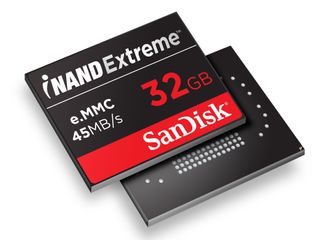Nvidia Uses SanDisk in Tegra 4 Tablet Reference Design
SanDisk's iNAND Extreme will be used in Tegra 4 tablet reference design.

SanDisk announced during Mobile World Congress 2013 that its iNAND Extreme Embedded Flash Drive (EFD) will be used in Nvidia's Tegra 4 tablet reference design. These tablets will come with 16 GB and 32 GB capacities although SanDisk offers the iNAND Extreme in capacities ranging from 16 GB to 128 GB.
"By pairing Tegra 4 with the iNAND Extreme, smartphone and tablet makers can create faster, quicker mobile devices with an even better consumer experience," said Phil Carmack, senior vice president, mobile business unit, Nvidia.
Nvidia introduced the Tegra 4 SoC last month at CES 2013 in Las Vegas. The company said that in-house reference designs optimized for the new SoC would not only speed up the process of bringing tablets and smartphones to the market, but help in the Tegra 4 adoption process for smaller OEMs.
The Tegra 4 chip, one of two in the Tegra 4 family, is designed for tablets and high-end smartphones. It features four ARM Cortex-A15 cores, Nvidia's custom power-saver core, and 72 custom GEForce GPU cores. Like the Tegra 4, SanDisk's iNAND Extreme was also developed for next-generation tablets, smartphones and other mobile devices, built on the company's 19-nm process technology.
SanDisk claims the INAND Extreme significantly improves multimedia synchronization speeds, file-transfer rates, and operating-system responsiveness. It features an advanced controller that "dramatically" enhances the sequential and random performance for applications using the Tegra 4 SoC. That means faster page loads, fluid framerates, quicker multi-shots and faster image captures.
According to the specs, the iNAND Extreme provides write speeds up to 45 MB/s, and read speeds up to 150 MB/s (the write IOPS is 800 and the read IOPS is 4,000). Other features include NTFS and WLK optimization, burst handling, high priority interrupt, packed command and sequential cache.
"We knew we needed to offer an outstanding SanDisk flash memory storage solution to match up to NVIDIA’s impressive Tegra 4 processor," said Drew Henry, senior vice president, OEM marketing, SanDisk. "Our iNAND Extreme product provides tremendous storage performance and high reliability to the Nvidia Tegra 4 platform, drawing on SanDisk’s 25-year legacy of enabling the industry’s most innovative digital devices."
Stay on the Cutting Edge
Join the experts who read Tom's Hardware for the inside track on enthusiast PC tech news — and have for over 25 years. We'll send breaking news and in-depth reviews of CPUs, GPUs, AI, maker hardware and more straight to your inbox.
For more information about SanDisk's iNAND Extreme, head here.
-
kelemvor33 I totally misread that title and thought it said nVidia SUES Sandisk. I guess I've been reading too many Apple articles lately...Reply -
flowingbass hopefully that makes a tablet boot faster than an ssd equipped pc.Reply
and be able to copy data to and from it faster than usb 2.0 speeds. -
InvalidError flowingbassand be able to copy data to and from it faster than usb 2.0 speeds.That depends mostly on whether or not they implement USB3 endpoint on it. The way Android devices emulate USB storage rather than give direct block-level access also contributes to slowing things down.Reply -
fteoOpty6488 Well, if MS is going to resusitate Windows RT with Surface RT V2.0, they better get a Surface RT with this T4chip and its NAND as both were criticized as lagging compared to the competition. With all Android and phone players going Qualcomm, Nvidia might be the only thing left for MS to choose. Here in lies the opportunity, it will have a chance to deliver two or three models that will hit the form-factor segments. 10 Inch version (why do 10.6 inches which is way too big!) version clocked at 1.9Ghz turbo/1.6 normal, 8 inch model with 1600X1200 display (yes, 4:3 ratio for book form factor) 1.Ghz/1.7Ghz turbo. And a 7 inch model 1280X720 with 1.3Ghz cpu. All with sdcard slots. 8 inch model should have fullzide SDcard slot as well as microSD slot. {Note: there is plenty of space behind the kick-stand ...}Reply
Most Popular

